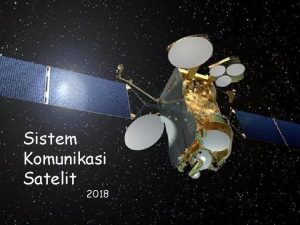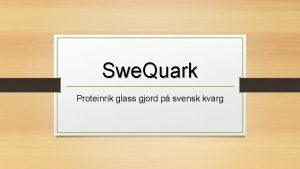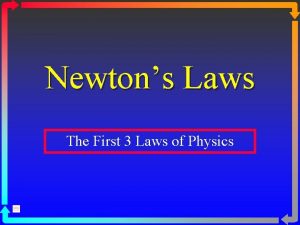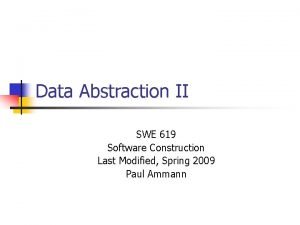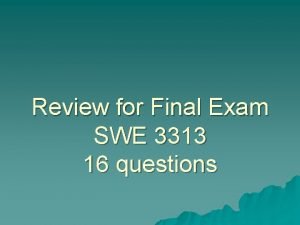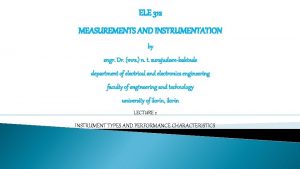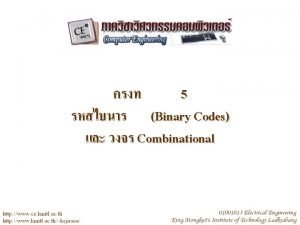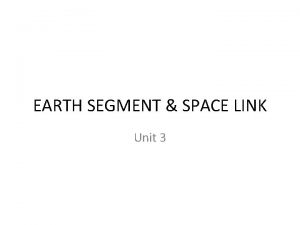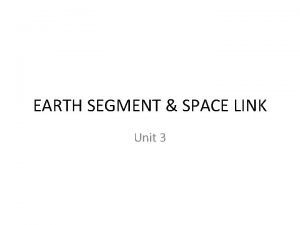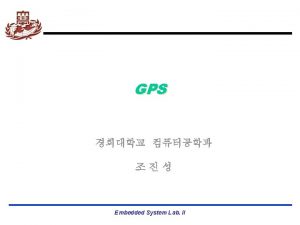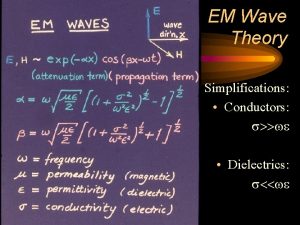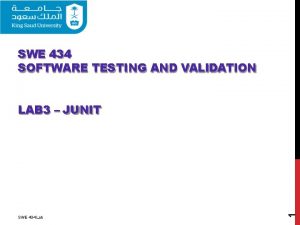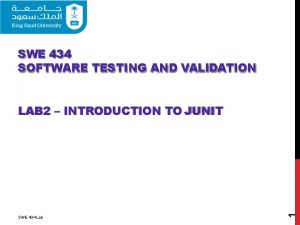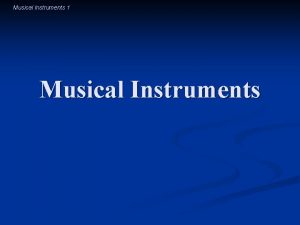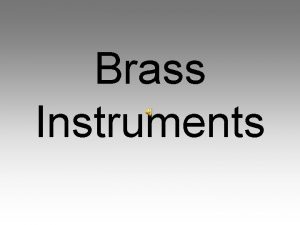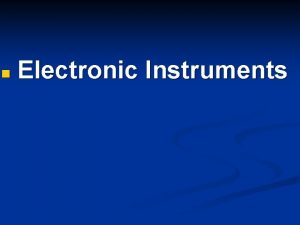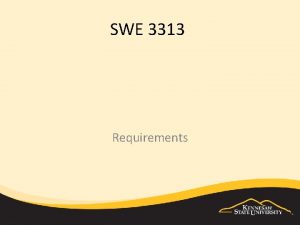D 3 S Instruments Requirements SWE Space Segment




















- Slides: 20

D 3 S Instruments Requirements SWE Space Segment 16/10/2019 ESA UNCLASSIFIED - For Official Use

Observational Requirements - D 3 S AORD ESA UNCLASSIFIED - For Official Use SWE Space Segment | 16/10/2019 | Slide 2

Measurement products to be provided by D 3 S ESA UNCLASSIFIED - For Official Use SWE Space Segment | 16/10/2019 | Slide 3

D 3 S – In-situ Instrument Suite The Instrument Package for the D 3 S - Small. Sat mission includes the following instruments: 1. Magnetometer (s-MAG) 2. Radiation Monitor (s-RM) 3. Multi-Needle Langmuir Probe (s-m. NLP) 4. Plasma Analyser (s-PLA) 5. Micro Particle Detector (s-MPD) 6. Medium Energy Particle Spectrometer (s-MEPS) 7. Oxygen Sensor (s-OXY) 8. Accelerometer (s-ACC) – optional 9. Energetic Neutral Atoms (s-ENA) - optional 10. GNSS receiver 11. Any other …. ESA UNCLASSIFIED - For Official Use SWE Space Segment | 16/10/2019 | Slide 4

Magnetometer (s-MAG) Observational Requirements The Magnetometer shall measure the 3 components of the magnetic field vector. The Magnetometer shall have a dynamic range for every component along negative and positive axis of 1 to 6*104 n. T. The Magnetometer absolute accuracy shall be better than 1 n. T (TBC). Note: Intrinsic accuracy of the Magnetometer disregarding disturbances of the S/C. The Magnetometer shall measure with a time resolution of 1 minute (1 sec). ESA UNCLASSIFIED - For Official Use SWE Space Segment | 16/10/2019 | Slide 5

Magnetometer (s-MAG) Design Requirements The mass of the Magnetometer shall be less than 1. 5 kg (TBC), divided between the 2 sensors, the harness, the electronics unit and the boom. The power consumption of the Magnetometer shall be less than 1 W (0. 5 W) in Operational Mode. The Magnetometer data rate shall be less than 0. 5 kbps. The MAG dimensions (with margin) shall be less than: - Sensor (x 2): 90 x 20 x 96 mm 3 - Electronics: 100 x 40 mm 3 The instrument concept shall be such that the required magnetic cleanliness of the S/C is minimised (the least demanding). ESA UNCLASSIFIED - For Official Use SWE Space Segment | 16/10/2019 | Slide 6

Radiation Monitor (s-RM) Observational Requirements The RM instrument shall provide in-situ measurements of • • • protons with kinetic energies between 2 Me. V and 500 Me. V (1 Ge. V). electrons with kinetic energies between 100 ke. V and 8 Me. V. ions with kinetic energies between 10 Me. V/nuc and 500 (1 Ge. V) Me. V/nuc. The RM instrument shall be sensitive to protons, alpha particles, the CNO group, Fe, Si, and Ne, and resolve for energies up to 200 Me. V/nuc the He 3 and He 4 ions (goal: resolve C, N and O). The RM instrument shall have a dynamic range sufficient to capture extreme flux during a solar event. (Note: The extreme flux is specified in the Environmental Document. ) The RM shall measure particle spectra with +/-30% (+/-20%) absolute accuracy (for fluxes above 10 particles cm-2 s-1 sr-1) in each energy channel. The Radiation Monitor shall have a measurement cadence of 5 min (1 min). ESA UNCLASSIFIED - For Official Use SWE Space Segment | 16/10/2019 | Slide 7

Radiation Monitor (s-RM) Design Requirements The RM shall have a mass of less than 2 kg for the unit, divided between sensors (primary and directionality sensors), the harness and the electronics. The RM instrument shall have a power consumption of less than 1 W (0. 2 W). The RM instrument shall have a data rate of less than 1. 5 kbps. The RM instrument shall have a dimension (w/o margin) of less than 30 x 30 mm 3. ESA UNCLASSIFIED - For Official Use SWE Space Segment | 16/10/2019 | Slide 8

Multi-Needle Langmuir Probe (s-m. NLP) Observational Requirements The instrument shall provide measurements as 3 D electron density grids in m-3. The instrument shall have a dynamic range from 109 to 1014 m-3. The instrument shall measure electron density with +/-10% accuracy. The instrument shall perform measurements with a frequency of 500 Hz or more. The instrument shall have a measurement latency of 2 min. Note: This is the time until when measurement data are provided to the data processing ESA UNCLASSIFIED - For Official Use SWE Space Segment | 16/10/2019 | Slide 9

Multi-Needle Langmuir Probe (s-m. NLP) Design Requirements The LP instrument shall have a mass of less than 2 kg for the complete suite: - Boom system mass (two cassettes with 4 needle booms): 700 g - Electronic mass: 900 g - Harness: 400 g The instrument shall have a power consumption of less than: 5 W. Note: The input power during the boom deployment may be higher. The instrument shall have a data rate of less than 50 kbps. Note: The data rate needs to be evaluated during the mission study and is considered as mission average. The instrument shall have a dimension (w/o margin) of less than: - Boom Size (deployed – one cassette): 400 x 65 mm 3 - Electronic Unit: 120 x 60 x 110 mm 3 ESA UNCLASSIFIED - For Official Use SWE Space Segment | 16/10/2019 | Slide 10

Plasma Analyser (s-PLA) Observational Requirements The Plasma Analyser shall measure Thermal Ion Density and Temperature respectively in m-3 and e. V. The Plasma Analyser shall measure the Plasma Drift Velocity in m/s. The Plasma Analyser shall have for the density measurements a dynamic range from 105 to 1011 m-3. The Plasma Analyser shall have for the plasma drift velocity measurements a dynamic range from -10 to 10 km/s. The PLA instrument shall provide in-situ measurements of ions with kinetic energies between 10 (1) e. V/n and 30 ke. V/n. The PLA instrument shall provide in-situ measurements of electrons with kinetic energies between 10 (1) e. V and 30 ke. V. ESA UNCLASSIFIED - For Official Use SWE Space Segment | 16/10/2019 | Slide 11

Plasma Analyser (s-PLA) Design Requirements The PLA instrument shall have a total mass of less than 1 kg (0. 5 kg), comprehensive of all sensors plus electronics. The PLA instrument shall have a power consumption of less than 4 W. The PLA instrument shall have a data rate of less than 3 kbps. The PLA instrument shall have a dimension (w/o margin) of less than 150 x 60 x 120 mm 3. ESA UNCLASSIFIED - For Official Use SWE Space Segment | 16/10/2019 | Slide 12

Micro Particle Detector (s-MPD) Observational Requirements The MPD instrument shall measure sub-millimeter particles with mass >10 -15 g. Design Requirements The MPD instrument shall have a mass of less than 1. 5 kg for the complete suite - Sensor Unit: 560 g - Data Processing Unit: 740 g Note: Some data processing can potentially be performed by the data processing unit. The MPD instrument shall have a power consumption of less than 3 W. The MPD instrument shall have a data rate of less than 2 kbps. The MPD instrument shall have a dimension (w/o margin) of less than: - Sensor Unit: 157 x 135 x 47 mm 3 - Data Processing Unit: 156 x 136 x 43 mm 3 Note: Larger areas with a lower mass density may be considered. ESA UNCLASSIFIED - For Official Use SWE Space Segment | 16/10/2019 | Slide 13

Medium Energy Particle Spectrometer (s-MEPS) Observational Requirements The MEPS instrument shall measure medium energy ions with kinetic energy from 30 kev/nuc up to 8 Me. V/nuc. The MEPS instrument shall measure medium energy electrons with kinetic energy in the range 30 ke. V to 0. 6 Me. V. The MEPS instrument shall measure the following particles: electrons, protons, alpha particle, CNO group (goal: resolve He 3 and He 4, C, N and O, Si/Ne, Fe, Ni, plus single a measure for heavier ions). Note: The goal requirement shall apply for energies larger than 1. 5 Me. V/nuc. The requirement is TBC. The instrument shall have a dynamic range sufficient to capture extreme flux during a space weather event. Note: The extreme flux is specified in [AD-3]. The MEPS instrument shall provide measurements of particle spectra (flux) with a relative accuracy of ± 5% for electrons and of ± 15% for ions for each channel of the spectrum. Note: the requirements shall be met for the flux spectrum of a typical (to be agreed for each particle type) solar particle event. Relative accuracy shall be understood as the remaining uncertainty after correction for the instrument bias or systematic errors and excluding statistic errors due to the count rates. The MEPS shall provide measurements of particle spectra with ± 50% (± 40%) absolute accuracy. Note: It is assumed that the energy resolution of the instrument is commensurate to provide spectra with the demanded accuracy. ESA UNCLASSIFIED - For Official Use SWE Space Segment | 16/10/2019 | Slide 14

Medium Energy Particle Spectrometer (s-MEPS) Design Requirements The MEPS instrument shall have a mass of less than 2. 4 (2) kg for one unit with two dual sensors. The MEPS instrument shall have a power consumption of less than 10 W including margin. Note: this is assuming a single unit and 5 W for the operational heaters. The MEPS instrument shall have a data rate of less than 1 kbps (TBC). The MEPS instrument shall have a dimension of less than 300 x 160 x 175 mm 3 ESA UNCLASSIFIED - For Official Use SWE Space Segment | 16/10/2019 | Slide 15

Oxygen Sensor (s-OXY) Observational Requirements The OXY instrument shall provide in-situ measurements of atomic oxygen density. The OXY instrument shall detect Atomic Oxygen (AO) and Molecular Oxygen (O 2) in two channels. The OXY instrument shall provide measurements in m-3 or kg m-3. The OXY instrument shall have a (density) dynamic range from 108 to 1016 m-3. The OXY instrument shall measure pressure (dynamic range) between 10 -9 and 10 -5 mbar. The OXY instrument shall measure the oxygen pressure in 1000 to 4096 steps in 5 gain ranges. The instrument shall measure electron density with +/-20% accuracy. The instrument shall have a measurement cadence of 30 s. The instrument shall have a measurement latency of 2 min. ESA UNCLASSIFIED - For Official Use SWE Space Segment | 16/10/2019 | Slide 16

Oxygen Sensor (s-OXY) Design Requirements The OXY instrument shall have a mass of less than 0. 3 kg for the complete suite: The OXY instrument shall have a power consumption of less than 3 W. The OXY instrument shall have a data rate of less than TBD kbps. The OXY instrument shall have a dimension (w/o margin) of less than: - Complete configuration with housing: 100 x 46 mm 3 ESA UNCLASSIFIED - For Official Use SWE Space Segment | 16/10/2019 | Slide 17

Accelerometer (s-ACC) - optional Observational Requirements The ACC instrument shall provide in-situ measurements of atomic oxygen density. The ACC instrument shall provide measurements in m -3 or kg m-3. The ACC instrument shall have a dynamic range from 108 to 1016 m-3. The instrument shall measure electron density with +/-20% accuracy. The instrument shall have a measurement cadence of 30 sec. The instrument shall have a measurement latency of 100 min. ESA UNCLASSIFIED - For Official Use SWE Space Segment | 16/10/2019 | Slide 18

Accelerometer (s-ACC) - optional Design Requirements The ACC instrument shall have a mass of less than 4 kg. The ACC instrument shall have a power consumption of less than: 6. 5 W. The ACC instrument shall have a data rate of less than 1 kbps. The ACC instrument shall have a dimension (w/o margin) of less than: - Complete configuration with housing: 108 x 190 x 180 mm 3 ESA UNCLASSIFIED - For Official Use SWE Space Segment | 16/10/2019 | Slide 19

Thank you for coming! ESA UNCLASSIFIED - For Official Use 30/09/2016 SWE Space Segment | 16/10/2019 |Slide 20 20
 Arsitektur komunikasi satelit
Arsitektur komunikasi satelit Swe 432
Swe 432 Jeff offutt
Jeff offutt Swe 619
Swe 619 Kvargglass
Kvargglass ßwe
ßwe Swe 619
Swe 619 Swe exam sample
Swe exam sample Swe 619 gmu
Swe 619 gmu Jeff offutt
Jeff offutt Swe 432
Swe 432 Swe finance
Swe finance 3313 exam questions
3313 exam questions Swe mission statement
Swe mission statement Segment by segment invasion
Segment by segment invasion What is active instruments
What is active instruments Pressure measuring devices
Pressure measuring devices Passive space maintainer
Passive space maintainer Objective of hospital pharmacy
Objective of hospital pharmacy Camera space to world space
Camera space to world space Cartesian space vs joint space
Cartesian space vs joint space
